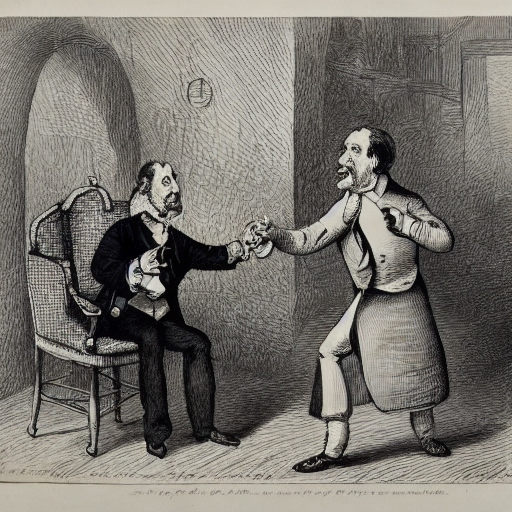
History has not been kind to George Cruikshank. Once the greatest illustrator and caricaturist of his day, Cruikshank's creative powers and popularity declined as he grew older and enfeebled by a stroke which left him with a tremor. After his death, Cruikshank was largely forgotten, despite the fact that some of his illustrations for Charles Dickens' Oliver Twist and for Sir Walter Scott's Waverly Novels, are frequently reprinted alongside the texts that they originally adorned.
A clue to the obscurity to which he has been relegated may lie in the fact that even during his life time, and despite his great popularity with the "masses", critics were divided on whether he was an artist or a hack. Criticisms of Cruikshank's work seemed to inhabit two extremes: those who saw in his work a modern incarnation of Hogarth and those who saw him as a vulgar tradesman of little talent.
The art critic Elizabeth Pennel stated:
"Few people can imagine the greater part of George Cruikshank's drawings to be anything but rubbish." -- Pennel
Even his then (at the time) friend Charles Dickens wrote an essay called "Frauds on the Fairies" in which he lampooned Cruikshank for his fanatical propaganda in favour of temperance, focusing his ire on the fact that Cruikshank had adapted children's fairy tales to his tee totaling purpose.

Julian Moore however wrote a spirited defence of Cruikshank's artistic talent, saying that "I strongly suspect that the authors of the denunciations I have quoted wrote without knowledge of the works on which the celebrity of Cruikshank chiefly rests, and that they judge him by ones that, although much the oftenest printed, are not among his best." (Introduction to "The three Cruikshanks. A Bibliographical Catalogue" (1897)
And the renowned art critic John Ruskin, however believed that Cruikshank's "realism and frank worldliness" was in some ways inspired by the works of Rembrandt. And he found Cruikshank's illustrations of Grimm's Fairy Tales to be "of quite sterling and admirable art".
The writer William Makepeace Thackeray wrote a retrospective which was partly biography and partly criticism in which he praised Cruikshank for his ability to entertain and to speak the truth through his art:
It is folly to say that this or that kind of humor is too good forthe public, that only a chosen few can relish it. The best humorthat we know of has been as eagerly received by the public as by themost delicate connoisseur. There is hardly a man in England who canread but will laugh at Falstaff and the humor of Joseph Andrews; andhonest Mr. Pickwick's story can be felt and loved by any personabove the age of six. Some may have a keener enjoyment of it thanothers, but all the world can be merry over it, and is always readyto welcome it. The best criterion of good humor is success, and whata share of this has Mr. Cruikshank had! how many millions of mortalshas he made happy! We have heard very profound persons talkphilosophically of the marvelous and mysterious manner in which hehas suited himself to the time--fait vibrer la fibre populaire (asNapoleon boasted of himself), supplied a peculiar want felt at apeculiar period, the simple secret of which is, as we take it, thathe, living amongst the public, has with them a general wide-heartedsympathy, that he laughs at what they laugh at, that he has a kindlyspirit of enjoyment, with not a morsel of mysticism in hiscomposition; that he pities and loves the poor, and jokes at thefollies of the great, and that he addresses all in a perfectlysincere and manly way. To be greatly successful as a professionalhumorist, as in any other calling, a man must be quite honest, andshow that his heart is in his work. -- from George Cruikshank
W.H. Chesson has commented that the reason for his comparative oblivion lies in the very same thing which made Cruikshank famous and popular in the first place:
The reason is that they [i.e. more enduring artists] have not been the journalists of their age. They have not, like Cruikshank, reflected in their works inventions and fashions, wars and scandals, jokes and politics, whence the world has emerged unrecognizably the same. -- from George Cruikshank, 1908In other words, the fact that most of his drawings were topical and dealt with issues of concerns of that period, meant that they became less relevant as the events they depicted ceased to be important. After all who really remembers the sex scandals of the Prince Regent in the 1700s or the controversy over the poll tax in 19th century England? However in my opinion there is no denying that Cruikshank's art transcends the time period and society from which it sprang. Like all true art it has, notwithstanding the controversy of the day quality of some his drawings, a timeliness which shines a light on the human condition. It is for this reason that George Cruikshank's art deserves to be viewed even today, and why notwithstanding the fact that his fame has faded, his work still can be found in major museums and art galleries throughout the world.








